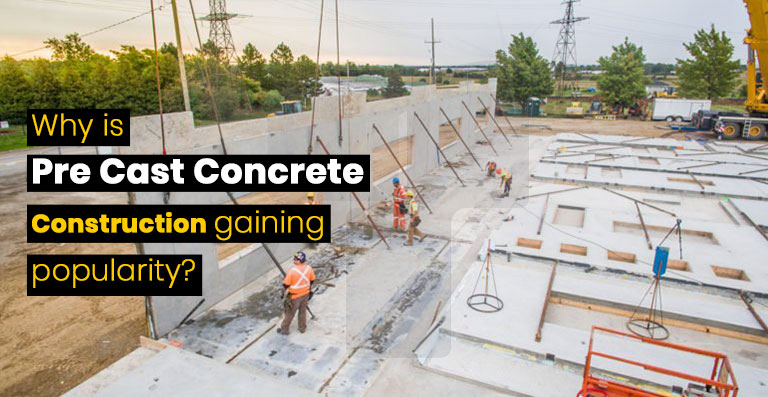Why is Pre Cast Concrete Construction gaining popularity?

Overview
Emergence of powerful and practical BIM tools for structural analysis, design and detailing has set in with the aid of continuous research and development in this field. They are gradually being adopted in structural engineering design firms. Indeed, best results can only be achieved when change extends beyond the borders of any individual organization adopting the technology.
The experiences of early adopters of BIM Services in structural engineering practice provide us the opportunity to know which practices work better and how it can be pursued along with its impact. BIM enables data to be organized and used/reused during the facility lifecycle to document transactions, identify data requirements specific to disciplines and inform business decisions to improve value.
Precast concrete is a construction method wherein the concrete is cast in reusable moulds and cured in a controlled environment, thereafter transported to the construction site for installation in the structure. The two main types of use are for structural elements (such as beams, columns and slabs, which may or may not be prestressed) and architectural facades.
BIM research and development for the architecture, engineering and construction industry in general focuses on provision of parametric 3D Modelling Services and on achieving interoperability between various applications. In the specific context of the precast industry the main efforts have been those of the Precast Concrete Software Consortium.
The directly quantifiable advantages of Structural BIM Services for the precast industry are relied upon significantly decreasing designing expenses and rework expenses due to errors, increases cost estimating precision, drastic decrease in building lead time, improved client assistance and backing for automation in production. Since BIM signifies a paradigm shift from the use of 2D CAD, the transition is likely to involve personnel concerns. It is also likely to present the opportunity for rethinking and possibly reengineering existing workflows and information flows in both engineering and in production. Companies should therefore carefully prepare strategies and working plans for the adoption phase and should implement monitoring procedures to enable benchmarking process.
During fabrication or erection of precast elements, geometry or connection errors on drawings can be costly to repair, so traditionally much time is spent on checking and vetting drawings. Technologists preparing traditional precast CAD drawings must use the 2D drawings and visualize the structure in 3D, and coordinate between numerous drawings to ensure nothing is overlooked. BIM could be used to review potential conflicts or project complications within the model, so they could be easily discovered and resolved prior to issuing drawings for construction. The use of the BIM software also inherently reduced the possibility of misaligned connections, incorrect architectural features, and geometry conflicts, so that shop drawings could be created without the need for detailed checking or cross coordination between drawings.
Benefits of adopting Pre Cast Construction
The pre cast construction process has the following perks if rightly implemented by the firms:
- It allows to increase the capability to absorb design changes with a minimum of rework in preparing and reconciling different drawings.
- It harnesses the capabilities of 3D visualization of the project in order to check for and avoid design errors. This is particularly necessary for viewing complex and congested arrangements of embeds, reinforcing and prestressed strands.
- Increases productivity by producing schedules and shop drawings for precast structures in automated fashion.
- It permits the owners to visualize the structure, specifically the spatial precast elements in three dimensions.
- Precast concrete construction is environment friendly and can help accomplish LEED points. This is because of the fact that the precast structures can be disassembled and utilized somewhere else.
- The concrete used to make the panels is bound to be of supreme quality on the grounds that the concrete is made and poured in a controlled situation.
- The panels can be planned, manufactured and raised a lot quicker than the standard cement pouring procedure. Thus, it is exceptionally engaging for ventures with tight timetables and spending plans.
- The panels normally require lower life cycle working expenses with reduced maintenance and decreased HVAC loads.
- The equipment required for standard cement pouring along with scaffolding equipment are never again required, which can assist with cutting project costs.
- Precast concrete panels allow accurate architectural detail at lesser cost.
- Long span systems can adjust to changing customer needs, boosting flexibility of utilization.
Conclusion
Adoption of BIM Structural Services in carefully measured stages is important. Firstly, the firms should focus on gaining basic modelling and drawing production skills before progressing to productivity enhancing functions such as the use of parametric custom components. Structural analysis using BIM data is considered to be a medium to long term goal. BIM is a powerful but complex technology. To make progress in adoption, firms must establish and maintain their organizational knowledge. It is important to develop, document and teach the modelling procedures that enable production of accurate drawings and material reports with as little manual editing effort as possible. With some formal training and consultation with an expert experienced in precast concrete can avoid incurring the costs of low productivity and rework as this knowledge is developed.
